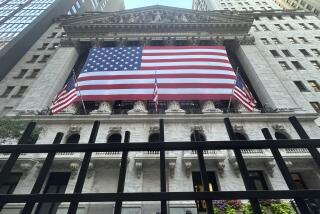Data in shortened week unlikely to calm market
The year is halfway over, and Wall Street appears to be on even shakier ground than when 2008 began. And this shortened week ahead of the Fourth of July holiday is unlikely to bring the market enough proof that the economic climate is improving.
The Dow Jones industrial average is down more than 14% for the year and has given up all the gains it made since September 2006.
Back in January, investors knew there was potential for the price of oil, which was on the verge of $100 a barrel, to keep rising, but most didn’t predict crude would surpass $140 a barrel. Economists figured that home prices had further to fall, but no one was sure how much. And when banks said the worst of the credit crunch was behind them in January, and then again in April, traders believed them.
Now, all the angst that has upended the stock market over the last year is back and more intense than ever. The main reason is that there is no historical precedent for what’s happening in the energy or credit markets.
“Take the models, throw them in the trash,” said David Kotok, chief investment officer of Cumberland Advisors. “Stocks do not like uncertainty, and they’ve got plenty of it.”
It’s possible that Wall Street is reaching its bottom, but investors -- who have been burned several times already -- don’t want to make that bet until they see clear, positive signs that inflation and economic growth are under control.
Wall Street this week is going to be watching the price of oil, as well as economic data. The most notable economic reading will probably be Thursday’s June employment report from the Labor Department, which is expected to show the sixth month of jobs losses and only a slight improvement in the unemployment rate.
Many observers believe the energy market is a bubble that will eventually burst, but no one knows when. Even if there is a significant pullback this week, the relief might prove temporary.
“The oil price rise has been surprising to nearly every forecaster,” Kotok said, noting that at $140 a barrel, crude imports will cost the U.S. approximately $700 million per day.
Last week, the Dow Jones industrial average fell 4.2%, the Standard & Poor’s 500 index ended down 3%, and the Nasdaq composite index closed 3.8% lower.
“I’m sort of in a state of shock watching the tape,” said Wall Street veteran Muriel Siebert on Thursday, as the Dow plummeted back toward levels not seen in nearly two years. Siebert runs discount brokerage Muriel Siebert & Co.
The optimists on Wall Street are hoping that last week’s plunge marks the third low in what stock market technicians call a “triple bottom” -- a trading pattern of three lows, followed by a rally. The Standard & Poor’s 500 index, one of the broadest measures of the stock market, briefly fell below the 1,280 mark this year in January, March and now June.
The pessimists, however, are saying that the market’s turmoil may be the start of a bear market, which is often calculated to be a drop of 20% from the last peak. All three indexes -- the Dow, the S&P; and the Nasdaq -- are nearly 20% below the high points they reached last fall.
In other economic data this week, the Institute for Supply Management will release its June indexes on the manufacturing and service sector, and the Commerce Department will report on construction spending in May.
The earnings calendar is light, with the markets closed Friday for the Fourth of July holiday. But later in July, the nation’s big commercial banks report their earnings -- and investors are girding for more massive write-downs on debt linked to risky mortgages.
“We don’t have a stable financial situation right now,” Siebert said. “The banks are in trouble -- I don’t know how they bought all that garbage.”
Meanwhile, with corn and other food at record highs, many emerging markets around the world are suffering even more than the United States, Siebert said. “The inflation problems could take two or three years to really solve.”
--
At a glance
Today
Congress expected to be on break until July 8.
Treasury bill auction.
H&R; Block releases fourth-quarter financial results.
Tuesday
The Institute for Supply Management releases its manufacturing index.
Commerce Department reports on construction spending for May.
Major carmakers report U.S. auto sales.
Wednesday
Commerce Department reports on factory orders for May.
Thursday
The Institute for Supply Management releases its non-manufacturing index.
Labor Department reports on employment for June.
Labor Department reports on weekly jobless claims.
Freddie Mac reports on mortgage rates.
Source: The Associated Press
More to Read
Inside the business of entertainment
The Wide Shot brings you news, analysis and insights on everything from streaming wars to production — and what it all means for the future.
You may occasionally receive promotional content from the Los Angeles Times.










